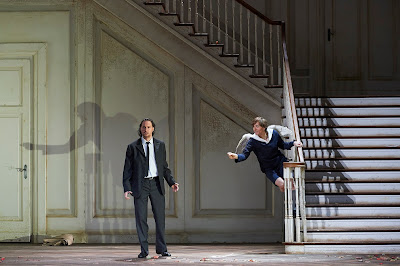Reviewed by James Karas
Claus Guth, the director of the current production of The Marriage of Figaro for the Canadian Opera Company tells us in a note that “he wanted to follow the characters into their darkest psychological depths.” He has found the shortest route to making one of the most enjoyable of operas into a dreary three and a half hours despite some excellent singing.
Let’s start with the set by designer Christian Schmidt. It consists of a grand but unadorned staircase. This bottom of the staircase is supposed to be Figaro’s room where he takes measurements for his bed while Susanna is showing her new hat. He is not really measuring and she does not have a hat. The set for the Countess’s bedroom in the next act is an unadorned room without a stick of furniture. Has the Count invested his money in oil or perhaps subprime mortgages and fallen on bad times? Guth created this production in 2006 for the Salzburg Festival
A scene from The Marriage of Figaro, 2016, photo: Michael Cooper
Guth introduces a new character into the opera, “a kind of Eros angel” he calls him. This is an athletic youngster, played by Uli Kirsch, with white wings who appears regularly. Initially he is mildly annoying but progresses into a major nuisance and ends up as a pain in the ass.
The Marriage of Figaro has a good opera buffa plot with some very traditional motifs: the clever servants outwitting their masters; the course of young love obstructed by the old; the lost child reunited with his parents. All of these have existed since the dawn of comedy. Mozart’s music raises this conventional plot into something magical and thoroughly entertaining.
Figaro (sung by Josef Wagner) is a lovable rascal, clever on his feet and getting married to Susanna (Canadian soprano Jane Archibald) who is smarter than him. Wagner does deliver a good Figaro but he would have done much better, along with everybody else, if Guth had not hung a millstone around his neck not the least of which is Eros. We love Susanna because she is pretty, clever and sings marvelously – Archibald does, that is.
Baritone Russell Braun could be a perfect Count Almaviva if he did not have Eros climbing all over him. Almaviva is a petulant, jealous, selfish and shallow aristocrat who becomes bored with his wife and wants to seduce her maid. He is motivated by lust and not by love. He is not conflicted; he is just plain horny. But he does grow and in the end is capable of going down on his knee and asking for forgiveness in a sonorous voice full of nobility and gracious contrition.
Josef Wagner as Figaro and Uli Kirsch as Cherubim (Eros). Photo: Michael Cooper
Cherubino, the testosterone cannon kid, is a juice pants role for a mezzo-soprano. Guth has mezzo Emily Fons dressed in a school uniform looking like a twelve-year old who should be doing homework instead of zipping up his pants. Fons is forced to look unpleasant and unconvincing even if vocally quite accomplished.
Soprano Erin Wall as the Countess sang her big arias beautifully and movingly. She plays with her wedding dress on the steps when singing “Dove sono” but the splendour of the aria and her voice beat all.
Bartolo (Robert Pomakov), Don Basilio (Michael Colvin), Marcellina (Helene Schneiderman) are stock comic characters who are usually left lone by Eros and it is all for the better. They do a fine job as good singers and comic characters.
Johannes Debus conducted the COC Orchestra for the marathon performance.
There is no shortage of bold, imaginative and one may say unorthodox productions of Figaro. Peter Sellars placed it in the Trump Tower in New York with some major tweaks; Nicholas Broadhurst and Geoff Posner transferred it to the house of Sir Cecil Portico (Count Almaviva) in England at the time of the Faulklands invasion. The countess sings in English from her Lifestyle treadmill. Director John Dew decided that the Countess is an alcoholic. There are numerous such takes but most of them do not stray from the central fact that this is a comic opera even if it has some interesting social angles.
Guth’s forced interpretation reminds me of Freud’s comment about cigars. A cigar may look like a phallic symbol and psychiatrists can go to market analysing the simple pleasure of smoking. Freud’s comment was that a cigar is sometimes just a cigar. Guth should have taken the hint that an opera buffa is sometimes just an opera buffa and not an exploration of comic characters’ psychological depths.
_________
The Marriage of Figaro by Wolfgang Amadeus Mozart opened on February 4 and will be performed in repertory until February 27, 2016 at the Four Seasons Centre for the Performing Arts, 145 Queen Street West, Toronto, Ontario. Tel: 416-363-6671. www.coc.ca






